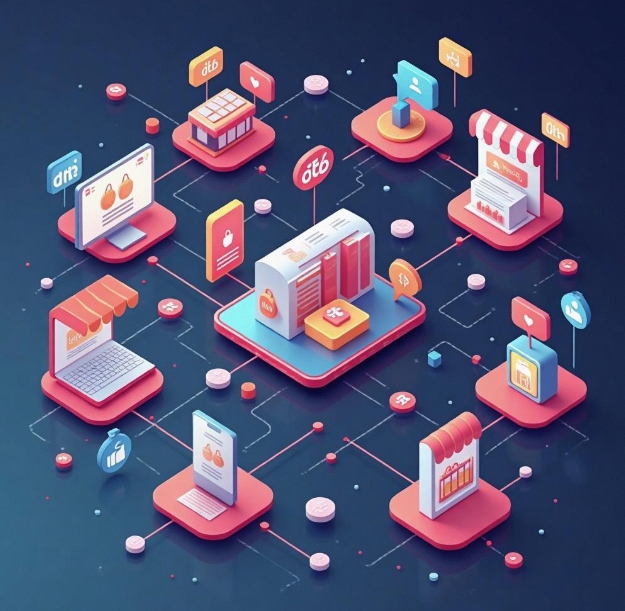Development of a Distribution System Integrated with Social E-commerce
- latest articles
- 1.DApp Development & Customization: Merging Diverse Market Needs with User Experience 2.Analysis of the Core Technical System in DApp Project Development 3.How to achieve cross-chain interoperability in Web3 projects? 4.How does the tokenization of points reconstruct the e-commerce ecosystem? 5.How to Set and Track Data Metrics for a Points Mall? 6.What is DApp Development? Core Concepts and Technical Analysis 7.Inventory of commonly used Web3 development tools and usage tips 8.Development of a Distribution System Integrated with Social E-commerce 9.Six Key Steps for Businesses to Build a Points Mall System 10.What is DApp Development? A Comprehensive Guide from Concept to Implementation
- Popular Articles
- 1.Future Trends and Technology Predictions for APP Development in 2025 2.Analysis of the DeFi Ecosystem: How Developers Can Participate in Decentralized Finance Innovation 3.From Zero to One: How PI Mall Revolutionizes the Traditional E-commerce Model 4.DAPP Development | Best Practices for Professional Customization and Rapid Launch 5.Recommended by the Web3 developer community: the most noteworthy forums and resources 6.From Cloud Computing to Computing Power Leasing: Building a Flexible and Scalable Computing Resource Platform 7.Shared Bike System APP: The Convenient Choice in the Era of Smart Travel 8.How to Develop a Successful Douyin Mini Program: Technical Architecture and Best Practices 9.How to Create a Successful Dating App: From Needs Analysis to User Experience Design 10.From Design to Development: The Complete Process of Bringing an APP Idea to Life
With the rapid development of internet technology, the e-commerce industry has entered a new era. Especially driven by social commerce, both the operational methods of e-commerce and the shopping habits of consumers have undergone profound changes. In this process, the distribution system, as a key tool supporting the development of social commerce, has gradually become an indispensable part of many e-commerce platforms. By empowering users to promote products and earn commissions, distribution systems facilitate the rapid spread and sale of goods. Meanwhile, social commerce leverages the advantages of social networks, turning users into product promoters and salespeople through sharing and interaction.
This article will explore how to develop an efficient distribution system and deeply integrate it with social commerce to drive the growth of e-commerce platforms and enhance user engagement.
I. What is a Distribution System?
A distribution system is a sales model that encourages users to share and promote products through a platform's reward mechanism. Its core idea is to disseminate product information to a broader potential consumer base by leveraging users' social networks, influence, and resources, thereby achieving sales growth. Traditional e-commerce platforms mostly rely on advertising, search engine optimization, and other methods to attract traffic. In contrast, under the social commerce model, distribution systems utilize users' social circles and trust relationships, focusing on "interpersonal recommendations" to create a more engaging and interactive communication model.
II. The Rise of Social Commerce
The emergence of social commerce is an innovation of the traditional e-commerce model. It uses social platforms (such as WeChat, Weibo, Douyin, etc.) as carriers to integrate users with e-commerce. The core characteristic of social commerce lies in the deep integration of "social" and "commerce," driving more purchasing behaviors through interactions, recommendations, and sharing among users.
The success of social commerce can be attributed to the following factors:
Establishment of Trust Relationships: In traditional e-commerce models, consumers often rely on platform and merchant advertisements to make purchasing decisions. In social commerce, users are more likely to decide whether to buy based on recommendations from friends or their social circles, resulting in higher trust.
Precise User Reach: Social commerce platforms can accurately recommend products to potential consumers by analyzing users' social behaviors, interests, shopping habits, and other information, thereby improving conversion rates.
Strong User Engagement: Social commerce platforms are highly interactive; users are not only consumers but can also become promoters or salespeople for products. By sharing product links or posting shopping experiences, users can earn certain commission rewards. This sense of participation motivates users and creates a virtuous cycle.
Low-Cost Promotion Methods: Compared to traditional advertising, social commerce achieves low-cost product promotion through users' spontaneous sharing. Meanwhile, word-of-mouth communication can rapidly increase product exposure.
III. The Integration of Distribution Systems and Social Commerce
Distribution systems and social commerce have a natural synergy. The essence of social commerce is driving sales through recommendations and sharing on social networks, while distribution systems incentivize consumption through user promotion. Therefore, integrating distribution systems with social commerce can better stimulate users' motivation to promote, enhancing platform sales and user engagement.
User-Created Distribution Networks
In traditional e-commerce platforms, users only play the role of consumers. In social commerce platforms, users can not only purchase products but also create their own distribution networks by sharing links, promoting products, and even inviting friends to join the platform. This network effect amplifies product exposure, turning every user into a potential promoter and salesperson.For example, a user purchases a product and shares a unique promotion link generated by the platform. When other users click the link and make a purchase, the original user receives a certain percentage of commission. This model not only drives users' desire to buy but also encourages them to make more recommendations and shares on social platforms.
Design of Reward Mechanisms
The core of a distribution system lies in its reward mechanism. Social commerce platforms typically set up different levels of commission rewards based on users' promotion activities. The design of the reward mechanism directly affects users' enthusiasm for promotion. For instance, tiered rewards based on sales volume can be established—the more products a user promotes and the higher the sales, the more generous the rewards. This tiered reward system effectively incentivizes users to expand their distribution networks and increase product sales.Additionally, platforms can organize special events, such as offering extra points or cash rewards for each product promotion during promotional periods like "Double 11." These activities not only boost user engagement but also drive product sales during specific times.
Social Sharing and Interaction
The integration of distribution systems and social commerce makes sharing and interaction a key factor in purchasing decisions. On social platforms, users can share product information through various means like friend circles, WeChat groups, and social media. These shares are often accompanied by recommendations and reviews, significantly influencing users' purchasing decisions. The social scenarios provided by platforms serve as fertile ground for product dissemination, where user recommendations are not just individual actions but part of the propagation through social relationship chains.For example, when a user shares a recently purchased piece of clothing in their friend circle along with a photo of themselves wearing it, their friends might be influenced and develop an interest in buying it. If the user also provides a personal discount coupon or a unique distribution link, the sharer can earn a commission when friends purchase the product. In this way, social sharing and interaction continuously amplify product exposure and sales.
Data Analysis and Intelligent Recommendations
The effectiveness of a distribution system depends not only on user participation but also on the platform's data analysis and intelligent recommendation technologies. By monitoring and analyzing user behavior data in real-time, the platform can accurately understand users' interests and needs, thereby pushing personalized product recommendations and improving purchase conversion rates.For instance, the system can analyze users' browsing history, purchase records, and social behaviors to identify their preferred product types or brands and conduct precise promotions within their social circles. This data-driven personalized recommendation greatly enhances the effectiveness of the distribution system, ensuring that users promote products more likely to attract others in their social networks rather than randomly.
IV. Technical Requirements for Developing a Distribution System
Multi-Channel Access and Integration
Social commerce platforms often involve multiple channels, including WeChat, Weibo, Douyin, short video platforms, etc. When developing a distribution system, it is essential to ensure seamless integration with these channels, supporting users in promoting and selling products across different social platforms.Real-Time Data Processing and Feedback
A distribution system needs to process large amounts of user behavior data in real-time and provide corresponding feedback based on the data. For example, when a user completes a purchase, the system must promptly update their distribution status and adjust their commissions and rewards according to sales performance. This requires the system to have efficient data processing capabilities and real-time feedback mechanisms.Security and Anti-Cheating Mechanisms
In the design of a distribution system, preventing cheating and abuse is crucial. For instance, some users might fraudulently obtain commissions through fake orders or other means. The platform must have effective anti-cheating mechanisms to ensure the system's fairness and transparency.User Experience Optimization
A distribution system must not only have robust functionality but also ensure a good user experience. When users promote products through social commerce platforms, the interface should be simple and easy to use, with smooth operational processes. Additionally, the system should provide clear earnings settlement and data statistics, allowing users to clearly understand their promotion effectiveness and income.
V. Conclusion
The integration of distribution systems and social commerce not only promotes sales growth for e-commerce platforms but also provides users with new profit opportunities. By building efficient and intelligent distribution systems, platforms can fully leverage the dissemination effects of social networks, achieving low-cost product promotion and high user engagement. However, to achieve this goal, the development of a distribution system requires not only strong technical support but also reasonable operational strategies and comprehensive user incentive mechanisms.
In the future, with the development of social commerce, distribution systems will become more intelligent and personalized, becoming a key competitive advantage for e-commerce platforms. Through more precise social interactions and data-driven recommendations, platforms can further enhance user engagement and build a powerful e-commerce ecosystem with strong social dissemination capabilities.
-

How does the tokenization of points reconstruct the e-commerce ecosystem?
With the continuous advancement of internet technology and the gradual prolifera···
-

How to Set and Track Data Metrics for a Points Mall?
With the rapid development of the e-commerce industry, points malls, as a common···
-

Development of a Distribution System Integrated with Social E-commerce
With the rapid development of internet technology, the e-commerce industry has e···

 Blockchain
Blockchain












